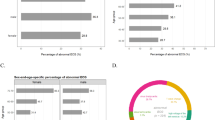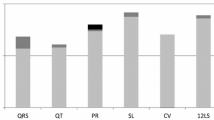Abstract
Observational studies have revealed that ischemic heart disease (IHD) has a unique manifestation on electrocardiographic (ECG). However, the genetic relationships between IHD and ECG remain unclear. We took 12-lead ECG as phenotypes to conduct genome-wide association studies (GWAS) for 41,960 samples from UK-Biobank (UKB). By leveraging large-scale GWAS summary of ECG and IHD (downloaded from FinnGen database), we performed LD score regression (LDSC), Mendelian randomization (MR), and polygenic risk score (PRS) regression to explore genetic relationships between IHD and ECG. Finally, we constructed an XGBoost model to predict IHD by integrating PRS and ECG. The GWAS identified 114 independent SNPs significantly (P value < 5 × 10–8/800, where 800 denotes the number of ECG features) associated with ECG. LDSC analysis indicated significant (P value < 0.05) genetic correlations between 39 ECG features and IHD. MR analysis performed by five approaches showed a putative causal effect of IHD on four S wave related ECG features at lead III. Integrating PRS for these ECG features with age and gender, the XGBoost model achieved Area Under Curve (AUC) 0.72 in predicting IHD. Here, we provide genetic evidence supporting S wave related ECG features at lead III to monitor the IHD risk, and open up a unique approach to integrate ECG with genetic factors for pre-warning IHD.




Similar content being viewed by others
Data availability
The datasets analyzed during the current study are available in the FinnGen, https://www.finngen.fi/en, and UK Biobank https://www.ukbiobank.ac.uk/.
Abbreviations
- IHD:
-
Ischemic heart disease
- ECG:
-
Electrocardiographic
- UKB:
-
UK Biobank
- SMR:
-
Summary databased Mendelian randomization
- GWAS:
-
Genome-wide association studies
- LDSC:
-
Linkage disequilibrium score regression
- SNP:
-
Single nucleotide polymorphism
- MR:
-
Mendelian randomization
- IVW:
-
Inverse variance-weighted
- GSMR:
-
Generalized summary data-based Mendelian randomization
- CAUSE:
-
Causal analysis using summary effect estimates
- LCV:
-
Latent causal variable
- HEIDI:
-
Heterogeneity in dependent instruments
- GCP:
-
Genetic causality proportion
- CI:
-
Confidence intervals
- PRS:
-
Polygenic risk score
References
Abecasis GR, Altshuler D, Auton A, Brooks LD, Durbin RM, Gibbs RA et al (2010) A map of human genome variation from population-scale sequencing. Nature 467(7319):1061–1073
Alghatrif M, Lindsay J (2012) A brief review: history to understand fundamentals of electrocardiography. J Commun Hosp Internal Med Persp 2(1):14383
Aung N, Vargas JD, Yang C, Cabrera CP, Warren HR, Fung K et al (2019) Genome-wide analysis of left ventricular image-derived phenotypes identifies fourteen loci associated with cardiac morphogenesis and heart failure development. Circulation 140(16):1318–1330
Bulik-Sullivan BK, Loh P-R, Finucane HK, Ripke S, Yang J, Patterson N et al (2015) LD Score regression distinguishes confounding from polygenicity in genome-wide association studies. Nat Genet 47(3):291–295
Chen T, He T, Benesty M et al (2015) Xgboost: extreme gradient boosting. R package version 0.4-2 1(4):1–4
Choi SW, Mak TS-H, O’Reilly PF (2020) Tutorial: a guide to performing polygenic risk score analyses. Nat Protoc 15(9):2759–72
Dalos D, Spinka G, Schneider M, Wernly B, Paar V, Hoppe U et al (2019) New cardiovascular biomarkers in ischemic heart disease—GDF-15, a probable predictor for ejection fraction. J Clin Med 8(7):924
Davies NM, Holmes MV, Smith GD (2018) Reading Mendelian randomisation studies: a guide, glossary, and checklist for clinicians. BMJ (Clinical research ed.) 362:k601
Gagliano Taliun SA, VandeHaar P, Boughton AP, Welch RP, Taliun D, Schmidt EM et al (2020) Exploring and visualizing large-scale genetic associations by using PheWeb. Nat Genet 52(6):550–552
Kharel H, Pokhrel NB, Pokhrel B, Chapagain P, Poudel CM (2020) Implications of localized ST depression in a vascular territory and altered precordial T-wave balance in ischemic heart disease. Cureus 12(6):e8580
Kramer O (2016) Scikit-learn. Machine learning for evolution strategies. Springer, Berlin, pp 45–53
Kurki MI et al (2023) FinnGen provides genetic insights from a well-phenotyped isolated population. Nature 613:508–518
Lee CH, Cook S, Lee JS, Han B (2016) Comparison of two meta-analysis methods: inverse-variance-weighted average and weighted sum of Z-scores. Genom Inform 14(4):173–180
Li M, Kwok MK, Fong SSM, Schooling CM (2019) Indoleamine 2, 3-dioxygenase and ischemic heart disease: a Mendelian randomization study. Sci Rep 9(1):1–10
Lin S et al (2023) Inferring the genetic relationship between brain imaging-derived phenotypes and risk of complex diseases by Mendelian randomization and genome-wide colocalization. Neuroimage 279:120325
Lindow T, Pahlm O, Khoshnood A, Nyman I, Manna D, Engblom H et al (2020) Electrocardiographic changes in the differentiation of ischemic and non-ischemic ST elevation. Scand Cardiovasc J 54(2):100–107
Lo P-K, Wang F-F (2002) Cloning and characterization of human and mouse DDA3 genes. Biochimica Et Biophysica Acta—Gene Struct Expr 1579(2–3):214–218
Loh PR, Tucker G, Bulik-Sullivan BK, Vilhjálmsson BJ, Finucane HK, Salem RM et al (2015) Efficient Bayesian mixed-model analysis increases association power in large cohorts. Nat Genet 47(3):284–290
Loh PR, Danecek P, Palamara PF, Fuchsberger C, Reshef AY, Finucane KH et al (2016) Reference-based phasing using the Haplotype Reference Consortium panel. Nat Genet 48(11):1443–8
MacArthur J, Bowler E, Cerezo M, Gil L, Hall P, Hastings E et al (2017) The new NHGRI-EBI Catalog of published genome-wide association studies (GWAS Catalog). Nucleic Acids Res 45(D1):D896-d901
Makowski D et al (2021) NeuroKit2: A Python toolbox for neurophysiological signal processing. Behav Res Methods 53:1689–1696
Morrison J, Knoblauch N, Marcus JH, Stephens M, He X (2020) Mendelian randomization accounting for correlated and uncorrelated pleiotropic effects using genome-wide summary statistics. Nat Genet 52(7):740–747
Norland K, Sveinbjornsson G, Thorolfsdottir RB, Davidsson OB, Tragante V, Rajamani S et al (2019) Sequence variants with large effects on cardiac electrophysiology and disease. Nat Commun 10(1):4803
Ntalla I, Weng L-C, Cartwright JH, Hall AW, Sveinbjornsson G, Tucker NR et al (2020) Multi-ancestry GWAS of the electrocardiographic PR interval identifies 202 loci underlying cardiac conduction. Nat Commun 11(1):2542
O’Connor LJ, Price AL (2018) Distinguishing genetic correlation from causation across 52 diseases and complex traits. Nat Genet 50(12):1728–1734
Patel KK, Venkatesan C, Abdelhalim H, Zeeshan S, Arima Y, Linna-Kuosmanen S et al (2023) Genomic approaches to identify and investigate genes associated with atrial fibrillation and heart failure susceptibility. Hum Genom 17(1):1–36
Roth GA, Johnson C, Abajobir A, Abd-Allah F, Abera SF, Abyu G et al (2017) Global, regional, and national burden of cardiovascular diseases for 10 causes, 1990 to 2015. J Am Coll Cardiol 70(1):1–25
Sudlow C, Gallacher J, Allen N et al (2015) UK biobank: an open access resource for identifying the causes of a wide range of complex diseases of middle and old age. PLoS Med 12(3):e1001779
Torlay L, Perrone-Bertolotti M, Thomas E et al (2017) Machine learning–XGBoost analysis of language networks to classify patients with epilepsy. Brain Inf 4(3):159–169
Verweij N, Benjamins JW, Morley MP, Vegte Y, Harst P (2020a) The genetic makeup of the electrocardiogram. Cell Syst 11(3):229–238
Verweij N, Benjamins J-W, Morley MP, van de Vegte YJ, Teumer A, Trenkwalder T et al (2020b) The genetic makeup of the electrocardiogram. Cell Syst 11(3):229–38.e5
Xiu X, Zhang H, Xue A, Cooper DN, Yan L, Yang Y et al (2022) Genetic evidence for a causal relationship between type 2 diabetes and peripheral artery disease in both Europeans and East Asians. BMC Med 20(1):300
Yamaguchi S, Hamano T, Oka T et al (2021) Electrocardiogram findings at the initiation of hemodialysis and types of subsequent cardiovascular events. Hypertens Res 44(5):571–580
Young WJ, Lahrouchi N, Isaacs A, Duong T, Foco L, Ahmed F et al (2022) Genetic analyses of the electrocardiographic QT interval and its components identify additional loci and pathways. Nat Commun 13(1):5144
Zhang H, Xiu X, Xue A, Yang Y, Yang Y, Zhao H (2022a) Mendelian randomization study reveals a population-specific putative causal effect of type 2 diabetes in risk of cataract. Int J Epidemiol 50(6):2024–2037
Zhang H, Xiu X, Yang Y, Yang Y, Zhao H (2022b) Identification of putative causal relationships between type 2 diabetes and blood-based biomarkers in east Asians by Mendelian randomization. Am J Epidemiol 191(11):1867–1876
Zhao H, Nyholt DR, Yang Y, Wang J, Yang Y (2017) Improving the detection of pathways in genome-wide association studies by combined effects of SNPs from Linkage Disequilibrium blocks. Sci Rep 7(1):3512
Zhao H, Yang Y, Lu Y, Mort M, Cooper DN, Zuo Z et al (2018) Quantitative mapping of genetic similarity in human heritable diseases by shared mutations. Hum Mutat 39(2):292–301
Zhu Z, Zhang F, Hu H, Bakshi A, Robinson MR, Powell JE et al (2016) Integration of summary data from GWAS and eQTL studies predicts complex trait gene targets. Nat Genet 48(5):481–487
Zhu Z, Zheng Z, Zhang F, Wu Y, Trzaskowski M, Maier R et al (2018) Causal associations between risk factors and common diseases inferred from GWAS summary data. Nat Commun 9(1):1–12
Acknowledgements
We’d like to thank the UK Biobank (application #65805) and the FinnGen project for making the data available.
Funding
The work was funded by the National Key Research and Development Program of China (2020YFB0204803), the Natural Science Foundation of China (81801132, 81971190, 61772566), Guangdong Key Field Research and Development Plan (2019B020228001,2018B010109006, and 2021A1515010256), Introducing Innovative and Entrepreneurial Teams (2016ZT06D211), Guangzhou Science and Technology Research Plan (202007030010), and Mater Foundation.
Author information
Authors and Affiliations
Contributions
H. Zhao and Y.Yang designed the study. X.Wang performed the analyses with assistance from H. Zhang, M.Qi. X.Wang and H.Zhao wrote the manuscript. Y. Yang and H. Zhao supervised the study. All authors discussed the results and interpretation, and contributed to the final version of the paper.
Corresponding author
Ethics declarations
Conflict of interest
The authors declare no competing interests.
Additional information
Publisher's Note
Springer Nature remains neutral with regard to jurisdictional claims in published maps and institutional affiliations.
Supplementary Information
Below is the link to the electronic supplementary material.
Rights and permissions
Springer Nature or its licensor (e.g. a society or other partner) holds exclusive rights to this article under a publishing agreement with the author(s) or other rightsholder(s); author self-archiving of the accepted manuscript version of this article is solely governed by the terms of such publishing agreement and applicable law.
About this article
Cite this article
Wang, X., Qi, M., Zhang, H. et al. Genome-wide association and Mendelian randomization analysis provide insights into the shared genetic architecture between high-dimensional electrocardiographic features and ischemic heart disease. Hum. Genet. 143, 49–58 (2024). https://doi.org/10.1007/s00439-023-02614-5
Received:
Accepted:
Published:
Issue Date:
DOI: https://doi.org/10.1007/s00439-023-02614-5




